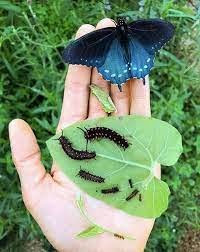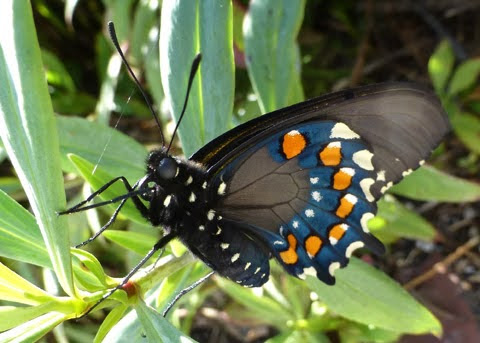Butterflies in OC
- OC Habitats
- Jan 5, 2024
- 3 min read
Butterflies are seen in numerous parts of Southern California. It is easy to name the well-known species such as Monarchs which we have covered in two previous articles (here and here), but Orange County is home to so many more beautiful butterfly species. This article will focus on two species of butterflies seen locally in Orange County, the Pipevine Swallowtail (Bantus philemon) and the California Dogface (Zerene Eurydice) butterfly.
Pipevine swallowtail. Photo Credit: Peter J. Bryant
Pipevine swallowtail (Bantus philemon) butterflies are predominantly black. They are large butterflies with iridescent blue on the outer side of both of their wings. They also have orange spots in between the blue on both wings making them distinct from other local swallowtails. They are established at Rancho Santa Ana Botanic Garden, where their food source has been plants such as petunias, verbenas, lupines, yellow starthistle, California buckeye, and many more that have been present for over three decades. This species is known to roam from city to city in Orange County and there have even been records of them in Arizona. They like to fly around warmer climate geographic locations. They are known to reproduce during spring and early summer. Pipevine swallowtails usually fly around from March through September. Their lifespan as adults is usually 6-14 days. An interesting fact about these butterflies is that although the Pipevine plant leaves are toxic to many vertebrate animals, the Pipevine swallowtail is able to adopt their chemical feature by feeding off it. While it is also known as its host plant at the larval stage. This feature they carry makes them less likely to be eaten or attacked by its predators.

The Dogface butterfly is a fellow butterfly that is native to our Orange County terrains. It also happens to be our state insect! When this butterfly is a caterpillar the California Dogface mainly feeds on the leaves of false indigo plant (Amorpha Californica). When viewing this species through a dorsal view it is primarily black with a pattern resembling a poodle's head, hence the name Dogface. These specific butterflies have 2 broods throughout the year. In simpler terms a brood is considered to be a single generation of butterflies in which they all fly during the same period of time. The first brood is between the months of April through July and the second being August through October. As adults their primary source of food would be the nectar of the Brassicaceae flower. The Brassicaceae is super important to this species survival along with many other California native plants. Those plants include California buckeye, thistles, and tall blue verbena. As for identifying whether the butterfly is a male or female there are different physical aspects in which they differentiate. The main difference is seen through their dorsal hind wing. Males dorsal hindwing are yellow or yellow-orange occasionally with a marginal black band while the female dorsal hindwing of this species is completely yellow with a hint of a dark spot on the forewing. As of where most of this species occupies terrain, most records of their presence are from the Santa Ana Mountains. They have also been found in the foothills of Fullerton and possibly in the hills near Brea.

Both of these butterflies all bring in a lot of contribution to our environment in Orange County. They are all great pollinators and when they pollinate it helps fruits, vegetables, and flowers produce new seeds. Through their pollination they help benefit humanity in so many ways. Majority of our plants need pollinators to continue to reproduce, so if there are no pollinators the likelihood of the plant surviving is unlikely. Having butterflies in our environment also indicates how healthy the environment we are living in is. If a garden is healthy and attracts butterflies it most likely means that it will attract native bees and birds too. It is all a cycle that is very important in increasing diversity in the various plants, animals, and many other organisms that Orange County has and needs.
Bringing awareness to the survival of butterflies in Orange County is very important. There used to be over 100 species that would roam around our county. Now that number has gone down to around 80 species. The greatest known threat for these animals is habitat loss due to residential and commercial development. Researchers also have found that climate change, widespread pesticide use, and invasive species are also threatening many species of butterflies. Because of these factors affecting the native host plants, it is a threat to their survival. One way in which we as a community can help resolve this issue could be as simple as planting and maintaining a native plant in our own yards. Each different species has specific host plants that nourish them from when they are larvae. Promoting awareness about these species and their habitats is vital to assure their survival in Orange County.
Sources
Pipevine swallowtail:
Dogface






